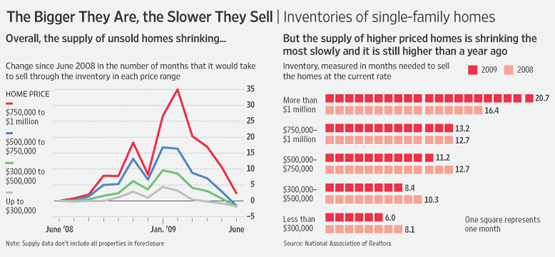“We’re in a ‘trade-down’ environment for the first time since the 1930s.”
-Kenneth Rosen, chairman of the Fisher Center for Real Estate and Urban Economics at the University of California, Berkeley.
>
A front page article in the WSJ divides the residential real estate market into two halves: low/moderate priced homes, and the upper end. The Journal observes:
Housing is fast dividing into two markets: Sales of low- and moderately priced homes are picking up and values have stopped falling in some parts of the nation. But on the upper end, sales remain mired in a deep slump and price declines are expected to accelerate.
Signs of the divide are visible across the country, including in suburban Chicago. In middle-class Schaumburg, Ill., which had a median income of $65,000 in 2007, sales were up 41% in June from the depressed level of a year earlier and bidding wars have broken out on some properties. “I can’t even tell you how many I’ve been in over the last two months,” says Joe Stacy, a local real-estate agent.
While that is one way to look at sales, I am not certain it is the dichotomy I would have chosen.
As to Bidding wars? I have no concrete evidence, but damn! that sound like so much NAR nonsense. Perhaps the agent was being coy when he said “I can’t even tell how many” bidding wars he was in. (Any local RE agents want to weigh in on this?)
There is, however, little doubt that the upper end of the market has not seen improvement. Sales at the high end of the Real Estate market are soft. That is partially a function of limited availability of credit and buyer concern over employment.
In the typical housing sale, there is often a chain of transactions, from the starter home to the larger family house to the bigger move up, on and on to the larger luxury houses. When any part of the chain is dysfunctional, the problem works its way upstream. The upper end was going to feel these effects eventually, and that day of reckoning seems to be here now. (One assumes the giant mansions purchased for cash are less impacted by this).
The lower end of the market, with tax cuts, local incentives (i.e., California) and lots of distressed inventory driving prices down has seen an uptick in activity. But if we want to split real estate into two halves, I would suggest looking at the following pairs:
• Bubble States / Non-bubble states;
• Distressed/Non-Distressed Properties
• Underwater/Non-Underwater mortgages
I suspect this might provide a better read on the true state of local real estate markets.
>
High End: More Inventory, Slower Sales

>
Source:
High-End Homes Frozen Out of Budding Housing Rebound
NICK TIMIRAOS and JAMES R. HAGERTY
WSJ, AUGUST 3, 2009
http://online.wsj.com/article/SB124924069909799645.html


What's been said:
Discussions found on the web: